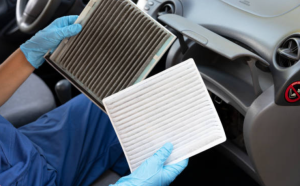Having issues with your car’s AC? Fear not! This guide will lead you through fixing it yourself, and if needed, we can also explore car assistance programs near me for additional support. Whether it’s a simple troubleshooting task or a complex component replacement, we have you covered. Ready your DIY spirit! First, gather the necessary tools – a refrigerant recharge kit, pressure gauge, multimeter, and wrenches. Don’t forget safety gear, such as gloves and goggles. Now, you’re set to begin diagnosing the issue. Patience is crucial, so take your time to ensure a successful repair. Follow along with us for a cool ride ahead!
Preparing for AC Repair
To prepare college students’ cars for AC repair, start by gathering the necessary tools, such as a refrigerant recharge kit, pressure gauge, and a leak detection kit.

Once you have the tools ready, you can then identify the problem’s source for cars for college students. This can involve checking for leaks in the AC system, inspecting the compressor, or troubleshooting electrical connections.
Gathering necessary tools
In order to successfully tackle the task of fixing the AC in your car, it’s essential to gather all the necessary tools beforehand.
Start by ensuring you have a set of basic hand tools such as screwdrivers, pliers, and wrenches. These tools will come in handy when removing any screws, bolts, or clamps during the repair process.
Additionally, you’ll need a refrigerant recovery machine to safely remove the refrigerant from the AC system before making any repairs.
A vacuum pump is also necessary to remove any moisture or air from the system, ensuring optimal performance.
Lastly, don’t forget to have a pressure gauge to measure the pressure levels in the AC system accurately. With all these tools ready, you’ll be well-prepared to fix your car’s AC and enjoy a cool and comfortable ride.
Identifying the source of the problem
First, assess the underlying issue by examining the various components of your vehicle’s cooling system.
Start by checking the AC compressor to see if it’s functioning correctly. Look for any signs of damage or leaks in the compressor.
Next, inspect the AC condenser and make sure it’s clean and free of debris. Clean it with a soft brush or compressed air if it’s dirty.
Then, check the AC hoses for any leaks or cracks. You can do this by running your hand along the hoses and feeling for any air escaping.
Additionally, examine the AC evaporator for any signs of blockage or damage.
Finally, check the AC refrigerant levels using a pressure gauge. If the refrigerant is low, you may need to recharge it.
By identifying the source of the problem, you can better determine how to fix your car’s AC.
Troubleshooting the Problem
To troubleshoot the problem with your car’s AC, start by checking the compressor. Make sure it’s running, and listen for any unusual sounds.

Next, check the condenser for any signs of damage or blockage.
Lastly, check the refrigerant level to ensure it’s at the proper level.
Checking the compressor
Next, you’ll want to ensure the compressor in your car’s AC system is functioning correctly. The compressor is responsible for pressurizing and circulating the refrigerant throughout the system.
To check if the compressor works, turn on your car and set the AC to the highest. Listen for any unusual noises coming from the engine, such as grinding or squealing sounds, which could indicate a problem with the compressor.
Additionally, you can visually inspect the compressor for any signs of leaks or damage. If you notice any issues, having a professional mechanic inspect and repair the compressor is recommended, as it can be a complex component to work on.
Checking the condenser
One crucial component to examine is the condenser ensuring its proper functioning. To check the condenser, start by visually inspecting it for any signs of damage or corrosion. Look for bent or damaged fins, which can obstruct airflow and reduce the cooling efficiency.
Next, use a multimeter to test the condenser for continuity. Set the multimeter to the ohms setting and touch the probes to the condenser terminals. A zero or low resistance value reading indicates continuity and a functioning condenser.
Additionally, clean the condenser using compressed air or a soft brush to remove any debris or dirt that may be blocking the airflow.
Regularly inspecting and maintaining the condenser can help optimize the performance of your car’s AC system.
Checking the refrigerant
Now let’s see how we can ensure your AC system runs smoothly by checking the refrigerant.
The refrigerant is a vital component of your car’s AC system, as it’s responsible for absorbing and releasing heat to cool the air that blows into the cabin.
To check the refrigerant level, start by locating the service ports on the AC lines. These ports are typically covered with plastic caps and can be found near the condenser or compressor.
Once you have located the ports, remove the caps and attach a pressure gauge to the low-side port. Start the engine and turn the AC on to its maximum setting.
The pressure gauge should give you a reading that falls within the manufacturer’s specified range. If the reading is too low, it indicates a refrigerant leak, and you should have it repaired by a professional.
If the reading is too high, it may mean that there is an overcharge of refrigerant, which can also lead to performance issues. In this case, you should have the refrigerant evacuated and recharged to the correct level.
Regularly checking the refrigerant level is essential to ensure your car’s AC system operates efficiently and keeps you cool during those hot summer months.
Replacing Parts
If you’re having issues with your car’s AC, there are a few parts that you may need to replace.

First, you might consider replacing the thermostat, which regulates the temperature in your car.
Next, the best online car auction sites can be an excellent resource for finding affordable replacement parts, including the evaporator, which may need to be replaced as it’s responsible for cooling the air before it enters the cabin.
Lastly, it’s possible that the compressor needs to be replaced, as it’s the heart of the AC system and is responsible for circulating refrigerant.
Replacing the thermostat
To fix your car’s AC, start by replacing the thermostat – it’s a simple fix that will have you feeling cool in no time!
First, locate the thermostat housing, which is usually located near the engine. Use a wrench to loosen the bolts and remove the housing carefully. Take note of how the old thermostat is positioned before removing it, as you’ll need to install the new one in the same way.
Clean the housing and ensure no debris or gasket material is left behind. Then, insert the new thermostat, ensuring it’s facing the correct direction.
Reattach the housing and tighten the bolts securely. Finally, refill the coolant if necessary and start your car to test the AC. You should now have a properly functioning AC system that’ll keep you comfortable on those hot summer days!
Replacing the evaporator
When it comes to getting your cool air flowing again, one crucial step to consider is replacing the evaporator. This component is responsible for cooling the air before entering your car’s cabin.
Over time, the evaporator can become clogged or damaged, leading to decreased cooling efficiency or even a complete loss of cold air. To replace the evaporator, start by disconnecting the battery to ensure safety.
Then, locate the evaporator housing, which is usually located behind the dashboard. Remove any necessary panels or components to access the housing.
Next, disconnect the refrigerant lines and drain any remaining refrigerant from the system. Carefully remove and replace the old evaporator with a new one, ensuring all connections are secure.
Finally, recharge the system with the appropriate refrigerant and test your car’s AC to ensure it works properly. Remember always to consult your car’s manual or seek professional help if you’re unsure about any step in the process.
Replacing the compressor
Replacing the compressor is essential in restoring the proper functioning of your vehicle’s air conditioning system. When the compressor fails, it can result in a lack of cold air or airflow.
To replace the compressor, you will first need to locate it in the engine compartment. It is typically attached to the engine with bolts and connected to the rest of the AC system with hoses.
Before starting the replacement process, make sure to relieve any pressure in the system by disconnecting the battery and wearing safety glasses. Once you have removed the old compressor, you can install the new one by attaching it to the engine and connecting the hoses.
Be sure to tighten all the bolts securely and check for any leaks. Finally, recharge the AC system with refrigerant according to the manufacturer’s instructions.
Replacing the compressor may require some mechanical knowledge and tools, so it’s always best to consult a professional if you’re unsure.
Conclusion
In conclusion, fixing the AC in your car can be a relatively easy task if you follow the right steps. By preparing for the repair and gathering the necessary tools and materials, you can save yourself time and frustration.
